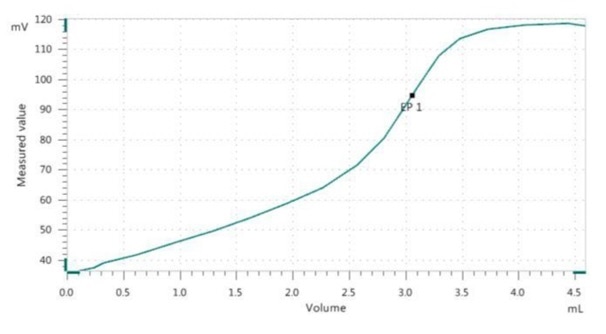Citrate is mainly used as a component of detergents to prevent calcification and to reduce hardness of water. Therefore, while determining the quality of detergents, citrate content is considered as an important parameter. The method utilizes cupric sulfate as the titrant.
Sample
Liquid hand soap
Sample Preparation
No sample preparation is required.
Analysis
5 to 10 grams of detergent sample is pipetted into a beaker and 150 mL of water is added by an automatic program. pH is then adjusted to nearly 8.5 using HCl with 0.1 mol/L concentration, followed by addition of 25 mL borate buffer.
The pH of the mixture is further adjusted to around 8.5 using NaOH with 0.1 mol/L concentration. The titration is then carried out using Cu-ISE as the indicator and CuSO4 with 0.05 mol/L concentration as the titrant until after the equivalence point is achieved.
Configuration
| . |
. |
| Main module Pick&Place S |
2.1010.0010 |
| Pick&Place module |
2.1014.0010 |
| "Peristaltic" (2-channel) pump module |
2.1016.0010 |
| Gripper fingers 42.8 - 65 mm |
6.02601.010 |
| Dummy panel for module plate |
6.02600.000 |
| OMNIS Rod Stirrer "Sample Robot" |
2.1006.0010 |
| Titration head 6xNS14 / 3xNS9 (P&P) |
6.01403.000 |
| Stirring propeller 30 mm ETFE |
6.01900.010 |
| OMNIS sample rack 9 x 250 mL, 2x |
6.02041.010 |
| Sample beaker (10x) PP 250 mL (P&P), 2x |
6.01400.100 |
| OMNIS Titrator (Advanced) |
2.1001.0210 |
| Cable MDL PL/SO 1 m, 4x |
6.02102.020 |
| OMNIS Dosing Module, 4x |
2.1003.0010 |
| OMNIS 5 mL cylinder unit, (EDTA solution) |
6.03001.150 |
| OMNIS 10 mL cylinder unit, 3x (hydrochloric acid, sodium hydroxide, titrant) |
6.03001.210 |
| OMNIS 50 mL cylinder unit, (borate buffer) |
6.03001.250 |
| Analog measuring module |
6.02101.010 |
| Cu-ISE |
6.0502.140 |
| Unitrode with Pt1000 (Head U) |
6.0258.600 |
| Electrode cable plug-in head G / plug P, 1.5 m for Cu-ISE |
6.02104.010 |
| Electrode cable plug-in head U / plug P, 1.5 m for Unitrode |
6.02104.610 |
| OMNIS Stand-alone license (including one instrument license) |
6.06003.010 |
| OMNIS instrument license, 1x |
6.06002.010 |
Solutions
| . |
. |
| Titrant |
c(CuSO4) = 0.05 mol/L |
| Borate buffer |
Borate buffer with pH = 8.5 |
| EDTA solution |
c(Na2EDTA) = 0.05 mol/L |
| HCl |
c(HCl) = 0.1 mol/L |
| NaOH |
c(NaOH) = 0.1 mol/L |
Parameters
| . |
. |
| Mode |
DET U |
| Pause |
30 seconds |
| Start volume |
(Sample size / 2) – 1.5 mL |
| Stirring rate |
8 |
| Signal drift |
30 mV/min |
| Max. waiting time |
32 seconds |
| Min. waiting time |
5 seconds |
| Dosing rate |
Maximum |
| Stop volume |
10 mL |
| Stop EP |
1 |
| Volume after EP |
1.0 mL |
| EP criterion |
10 mV |
| EP recognition |
Greatest |
Results
| . |
. |
| Content wCitric acid / (%) (n = 5) |
S(rel) / % |
| 0.40 |
1.77 |

About Metrohm
At Metrohm is one of the world’s most trusted manufacturers of high-precision instruments for chemical analysis. Metrohm was founded in 1943 by engineer Bertold Suhner in Herisau, Switzerland. Today, Metrohm is represented in 120 countries by subsidiaries and exclusive distributors. The global Metrohm Group also includes the Dutch companies Metrohm Applikon and Metrohm Autolab, manufacturers of online analyzers and instruments for electrochemical research, respectively. Recently, the Metrohm Group was joined by Metrohm Raman, a leading manufacturer of handheld Raman spectrometers.
Metrohm is the global market leader in analytical instruments for titration. Instruments for ion chromatography, voltammetry, conductivity, and stability measurement make the Metrohm portfolio for ion analysis complete. Instruments for Near-infrared and Raman spectroscopy are another, strongly growing segment of the Metrohm portfolio.
Metrohm is a problem solver, both in the laboratory and within the industrial process. To this end, the company offers their customers complete solutions, including dedicated analytical instrumentation as well as comprehensive application know-how. More than 30% of the company’s employees at the Metrohm international headquarters in Herisau work in R&D.
Metrohm has been owned 100% by the non-profit Metrohm Foundation since 1982. The Metrohm Foundation, which does not exert any influence on the company’s business operations, sponsors gifted students in the natural sciences, supports charitable and philanthropic purposes and, above all, ensures the independence of the company.
Sponsored Content Policy: News-Medical.net publishes articles and related content that may be derived from sources where we have existing commercial relationships, provided such content adds value to the core editorial ethos of News-Medical.Net which is to educate and inform site visitors interested in medical research, science, medical devices and treatments.